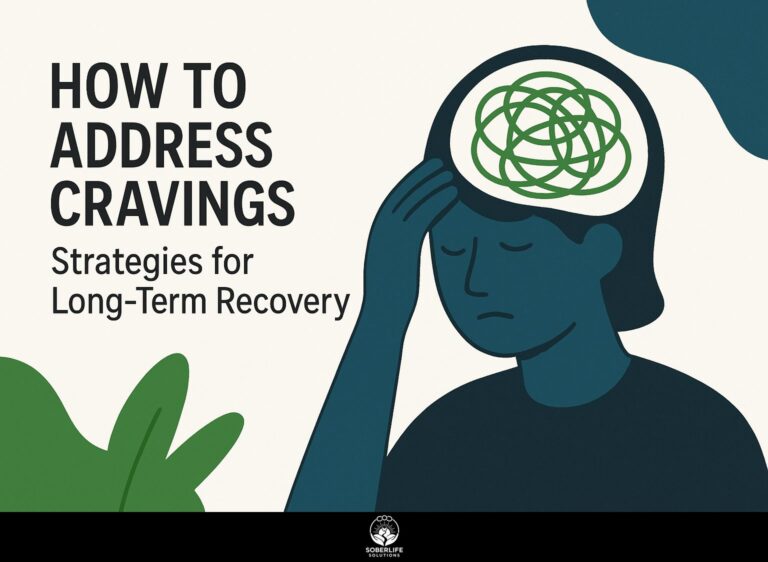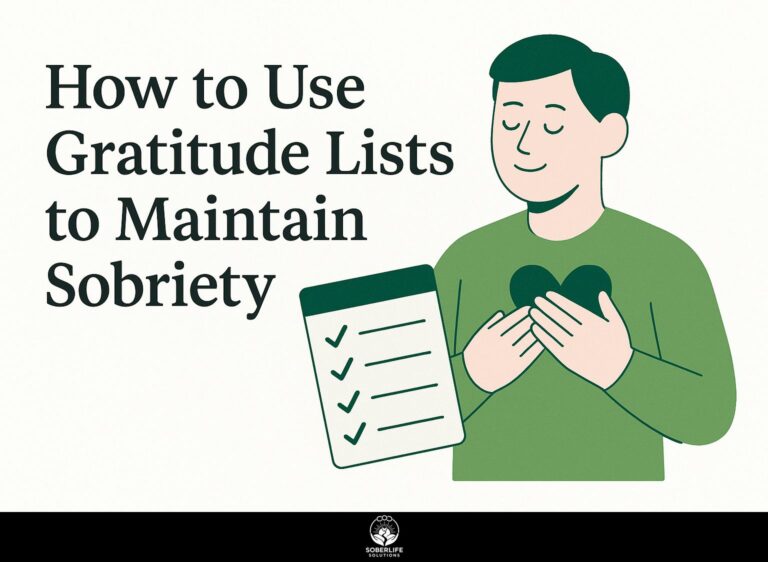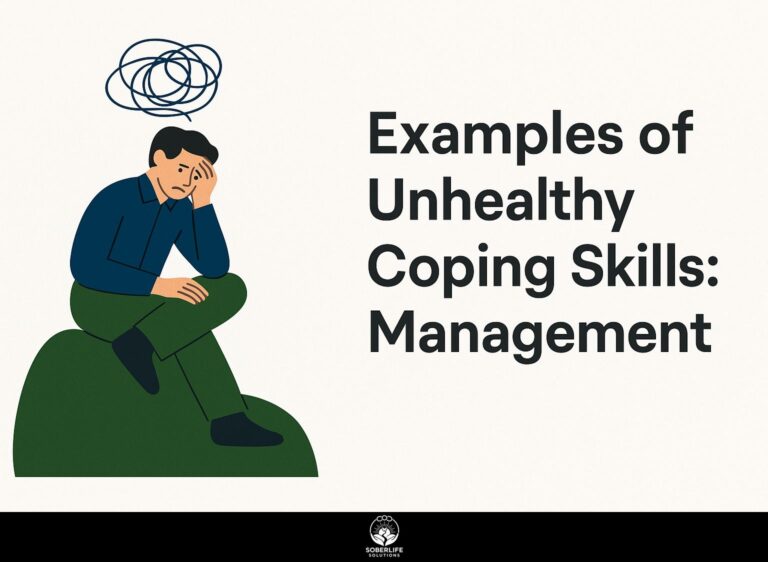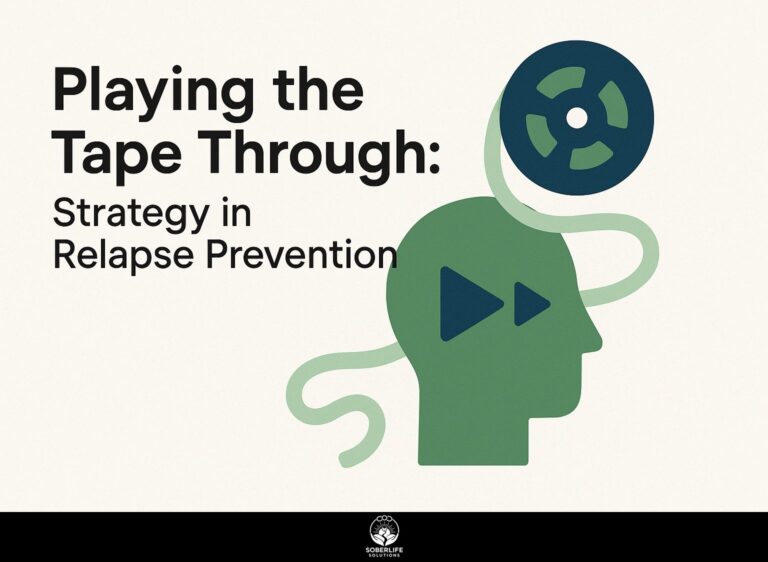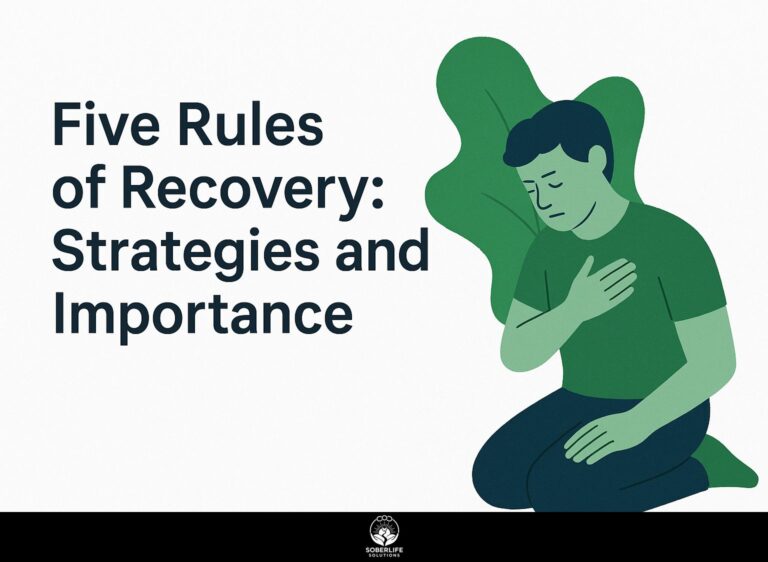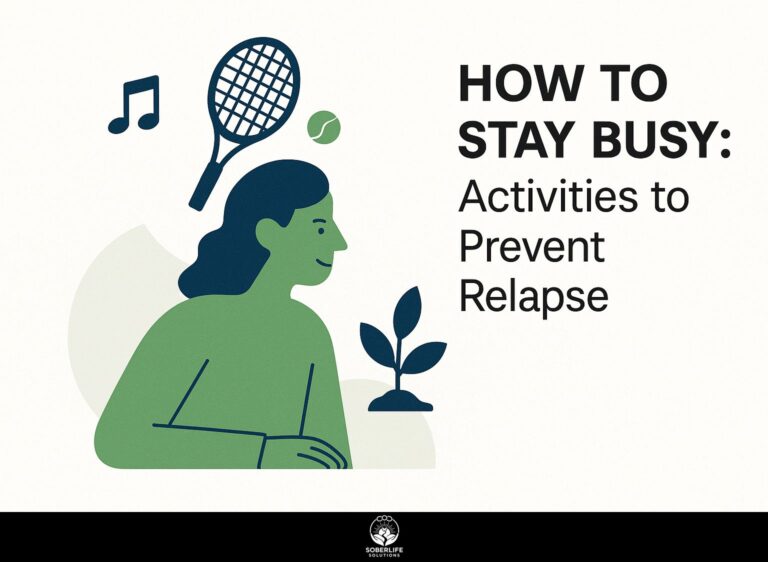Deep Breathing Techniques in Relapse Prevention
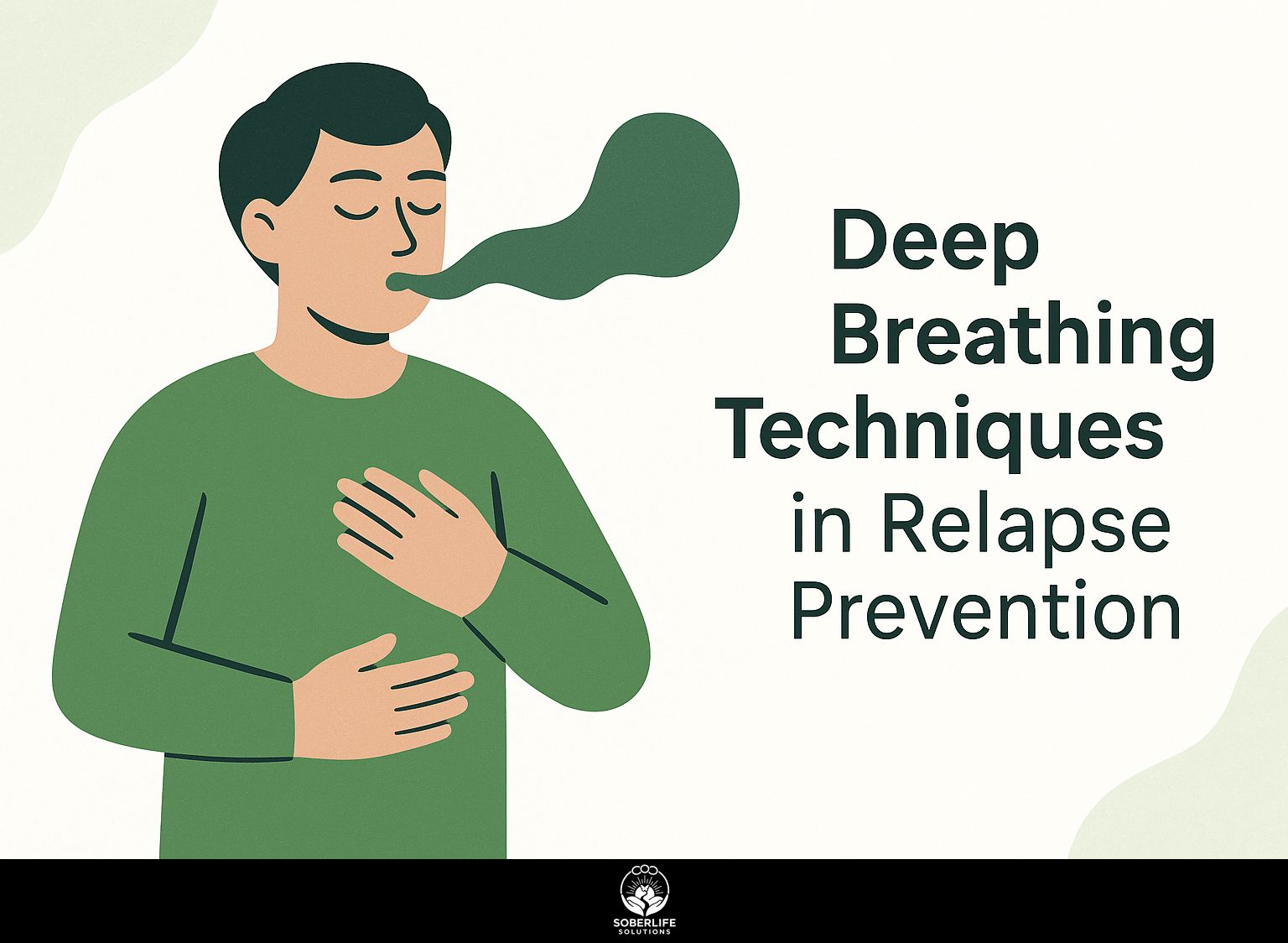
Feeling stressed can make you crave alcohol and feel bad. Deep breathing techniques, such as breath counting and mindfulness therapy, offer powerful tools for relapse prevention. By adding these habits to your daily routine, you can handle triggers well and build strength. In this article, we’ll look at different deep breathing techniques, their benefits, and how to include them in your life for long-term emotional balance and help with recovery.
Key Takeaways:
Definition and Importance
Breath counting is a mindfulness technique that focuses on the rhythm of breath, promoting relaxation and clarity, critical for managing stress levels in high-pressure situations.
To practice breath counting, find a quiet space and sit comfortably. Begin by inhaling deeply through your nose, then exhale through your mouth while counting ‘one.’ Continue this for ten breaths, counting each exhale.
This method helps people stay present during anxious or depressive moments and improves focus by shifting attention away from stress-inducing thoughts.
Apps such as Headspace or Calm offer guided sessions on focusing on your breath, which makes it simpler to learn this method. For context, a study published by ScienceDirect explores how ultra-brief breath counting training can promote mindfulness and support mental well-being.
Connection to Relapse Prevention
Using breath counting methods can greatly lessen emotional responses, which is important in preventing recurrence in people recovering from problematic drinking.
Research shows that mindfulness practices, such as breath counting, can decrease the likelihood of relapse by up to 50%. According to a recent analysis from Tandfonline, mindfulness-based relapse prevention is particularly effective in helping individuals sustain recovery and improve emotional health.
When an individual feels overwhelmed, setting aside just five minutes for focused breathing can calm the nervous system and provide clarity. Apps like Headspace provide guided breathing exercises that can improve emotional control. Creating a daily routine that uses these methods can build strength to resist triggers.
This proactive approach can lead to sustained recovery and better emotional health.
Understanding Relapse Triggers
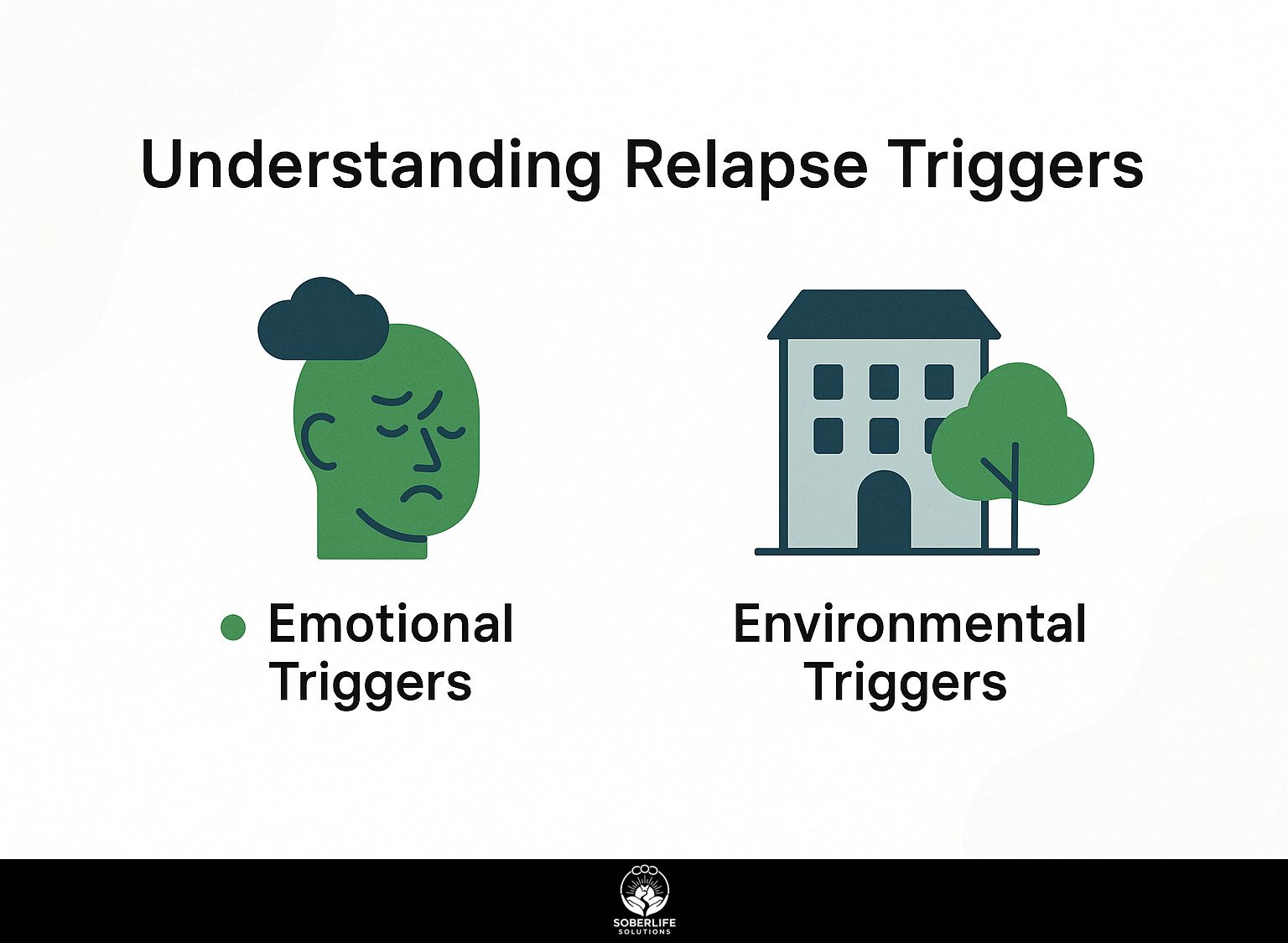
Knowing the various reasons for relapse, such as feelings or environment, is very important for those in recovery to remain sober and apply effective coping strategies. As noted in the Whole Health Library, understanding and addressing these triggers can significantly reduce relapse risk. In fact, learning about relapse triggers-their identification, risks, and prevention strategies-can empower individuals to take control over their recovery journey.
Emotional Triggers
Feeling sad or having mood swings can slow down recovery and make people start drinking again.
To handle these triggers well, people can use different ways to cope.
One effective tool is breath counting, where you inhale for a count of four, hold for four, and exhale for six. This technique helps center your mind and reduce anxiety.
Activities such as guided meditation or yoga can help you become more aware of yourself and improve how you handle emotions. For instance, an app like Headspace offers structured sessions that promote a positive outlook, helping manage cravings and maintain sobriety.
Environmental Triggers
Environmental triggers, such as social situations involving alcohol, can pose significant challenges for individuals in recovery, often leading to increased risk of relapse.
To handle these situations well, it’s important to plan ahead. Start by identifying specific triggers-this could be bars, parties, or gatherings with certain friends.
Develop a plan to cope: consider practicing deep breathing exercises before entering these environments to manage anxiety, or engage in mindfulness techniques to stay present.
Having a support buddy with you can provide comfort and distraction. Use apps like Sober Grid or I Am Sober. These apps provide community support and tracking tools to strengthen your commitment to staying sober.
Deep Breathing Techniques Overview
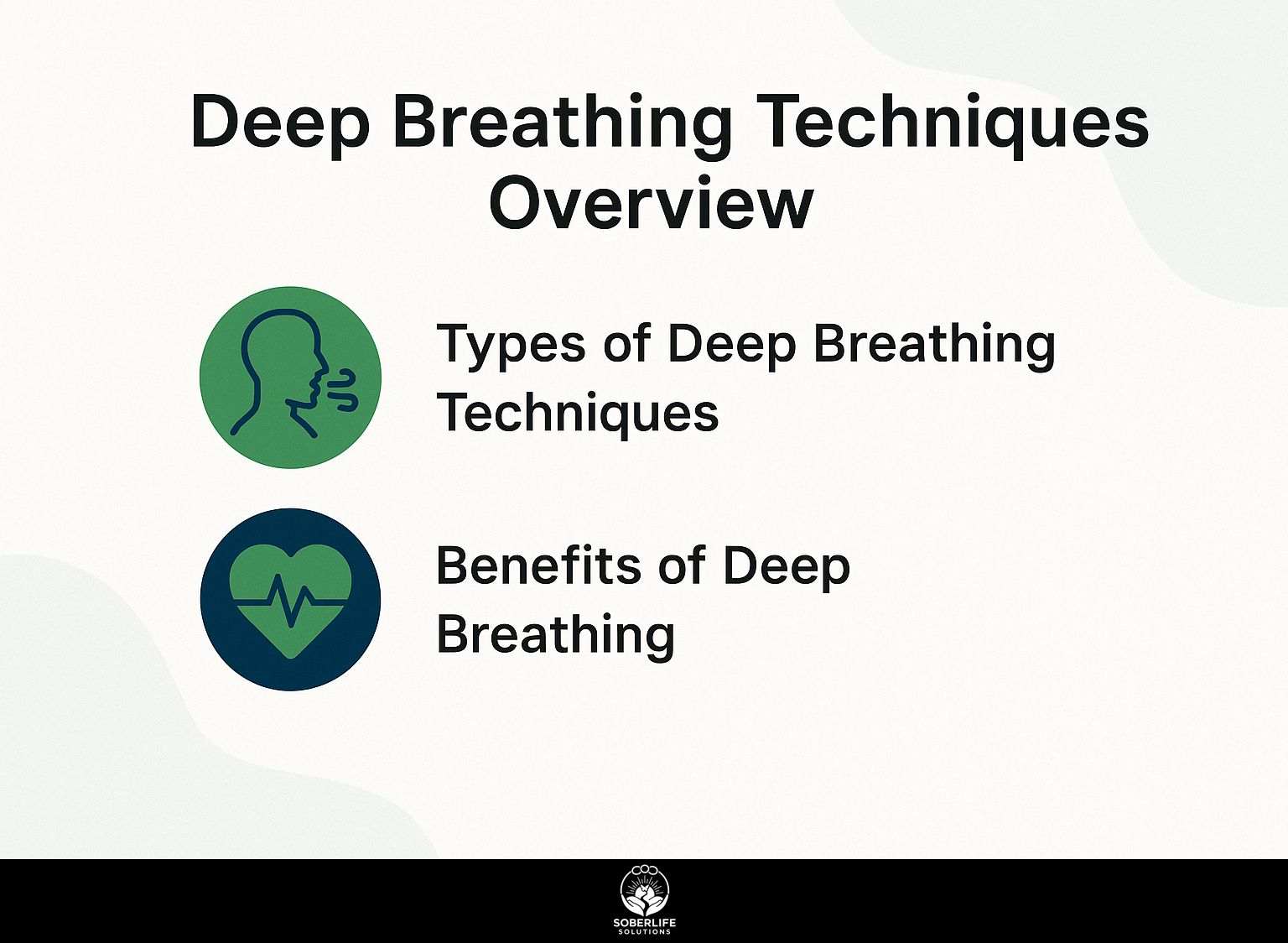
Deep breathing methods include different exercises that help you relax and control emotions, which are important for handling stress and anxiety well. For a deeper understanding of how these techniques can be integrated into recovery practices, explore our comprehensive guide on mindfulness and meditation.
Types of Deep Breathing Techniques
Common deep breathing methods are diaphragmatic breathing and box breathing. Both help individuals relax and build awareness in daily use.
Diaphragmatic breathing involves inhaling deeply through your nose, allowing your abdomen to expand, and then exhaling slowly through pursed lips.
To practice, sit comfortably, place one hand on your chest and the other on your belly, and focus on breathing so that only your belly rises.
Box breathing, on the other hand, consists of inhaling for four counts, holding for four, exhaling for four, and holding again for four before repeating. This method is effective for reducing anxiety before stressful situations, such as public speaking or important meetings.
Benefits of Deep Breathing
Research indicates that regular practice of deep breathing can lead to a 30% reduction in stress levels and increased resilience against emotional reactivity.
Engaging in deep breathing exercises can be particularly effective for stress management. For instance, techniques like the 4-7-8 method, where you inhale for 4 seconds, hold for 7 seconds, and exhale for 8 seconds, have been shown to promote relaxation and reduce anxiety.
Studies reveal that individuals practicing this method reported significant improvements in their stress perception and overall emotional stability. Doing these exercises every day, like during work breaks or before sleeping, can help you handle stress better and improve your overall well-being.
Implementing Deep Breathing in Daily Life
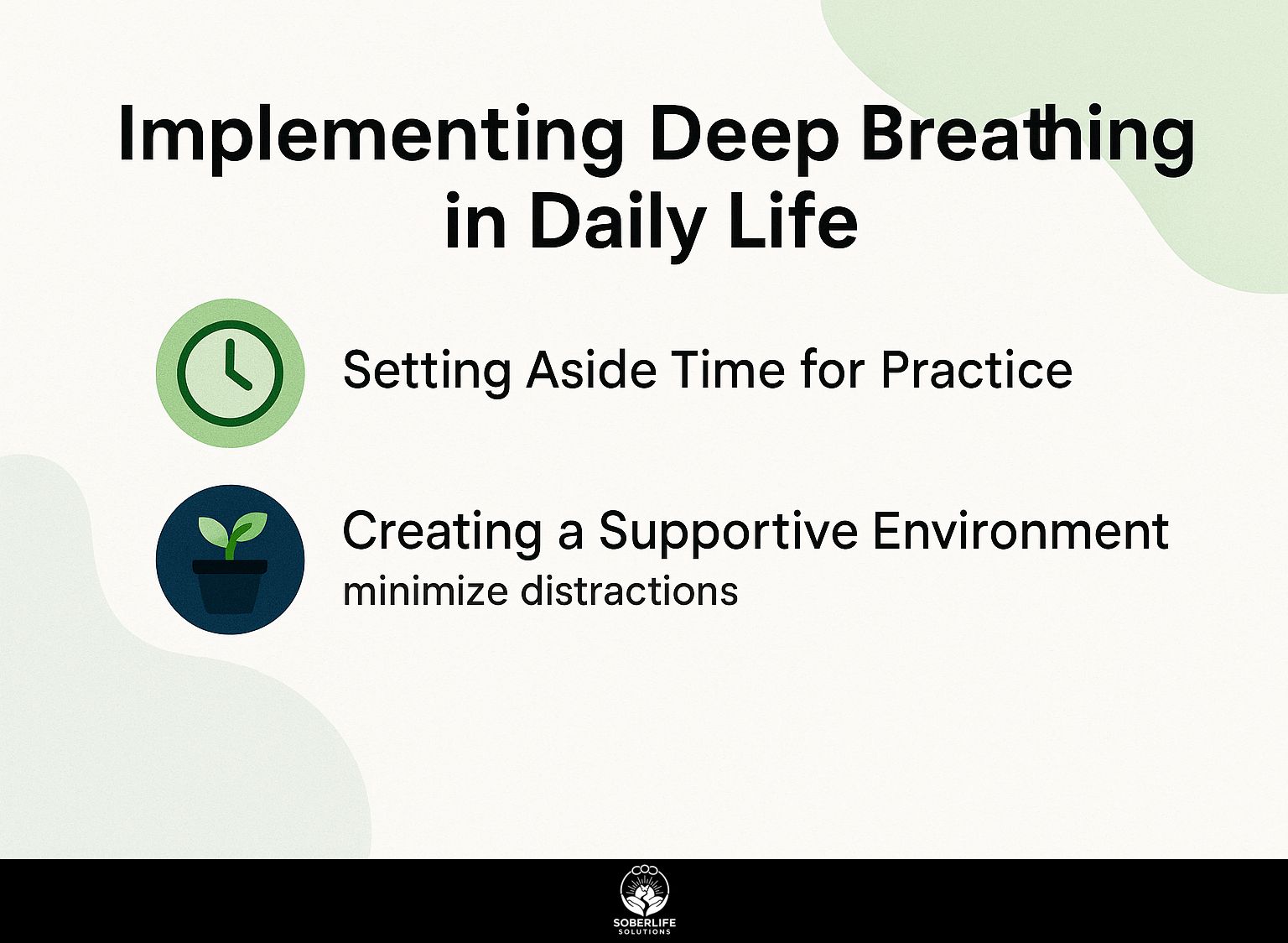
Adding deep breathing exercises to daily habits can greatly improve emotional health and resilience, especially in stressful situations. For those seeking more strategies to maintain emotional well-being, our comprehensive guide on Emotional Relapse: Signs and Coping Strategies offers valuable insights.
Setting Aside Time for Practice
Allocating just 10 minutes daily for deep breathing exercises can substantially improve emotional regulation and stress management over time.
To maximize the benefits, designate a specific time each day, such as first thing in the morning or during lunch breaks.
Use tools like a meditation app, such as Headspace or Calm, to help with your sessions. Begin with just five minutes, focusing on inhaling deeply through your nose and slowly exhaling through your mouth.
As you become comfortable, gradually extend the duration. Using your phone to set alerts can help make this routine a normal part of your daily schedule.
Creating a Supportive Environment
Creating a calm space, without interruptions, is important for getting the most out of breathing exercises and mindfulness activities.
To improve this environment, think about these practical tips:
- Minimize noise by utilizing noise-canceling headphones or soft background music.
- Use calming visuals like plants or peaceful artwork to make the space feel calm.
- Put notes in specific places that encourage you to take deep breaths.
These easy suggestions can help you improve your routine and make it more steady, allowing you to create a habit that supports clear thinking and overall health.
Combining Deep Breathing with Other Strategies
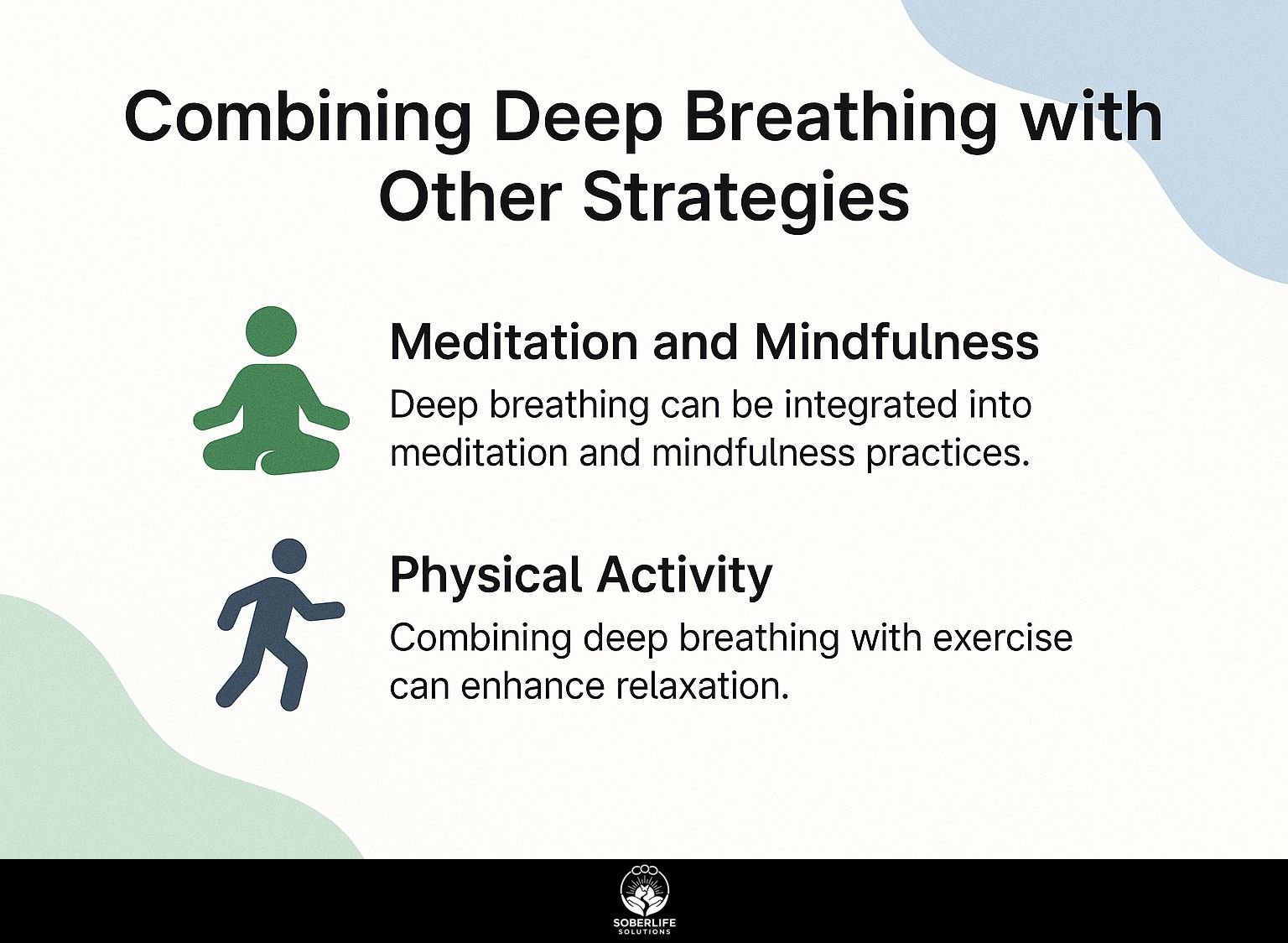
Using deep breathing techniques along with meditation and physical activity can help reduce stress and improve emotional health. Worth exploring: Recovery Techniques: Mindfulness, Meditation, and Stress Reduction for more insights into how these practices can be integrated for enhanced well-being.
Meditation and Mindfulness
Practicing mindfulness meditation with deep breathing can increase awareness and improve control over emotions during stressful times.
To include breath counting in your mindfulness routine, start by locating a peaceful area. As you settle into a comfortable position, take a few deep breaths to calm your mind.
Count each exhale from one to ten, resetting back to one when you reach ten. This simple technique grounds your focus and redirects wandering thoughts.
You might look into apps such as Headspace or Calm, which provide guided exercises centered on breathing awareness. Practicing for just 10 minutes each day can greatly improve your mindfulness skills and help you handle stress better.
Physical Activity
Exercising and practicing deep breathing improve heart health and reduce stress and anxiety.
To effectively combine deep breathing with physical activities, consider trying yoga and walking.
In yoga, focus on the Ujjayi breath-inhale deeply through your nose, allowing your abdomen to rise, then exhale slowly. For example, during a downward dog, maintain this breath pattern to deepen your stretches.
When walking, practice rhythmic breathing: inhale for four steps, then exhale for another four. This method helps increase oxygen flow and promotes mindfulness, making both exercises soothing and beneficial.
Measuring Effectiveness
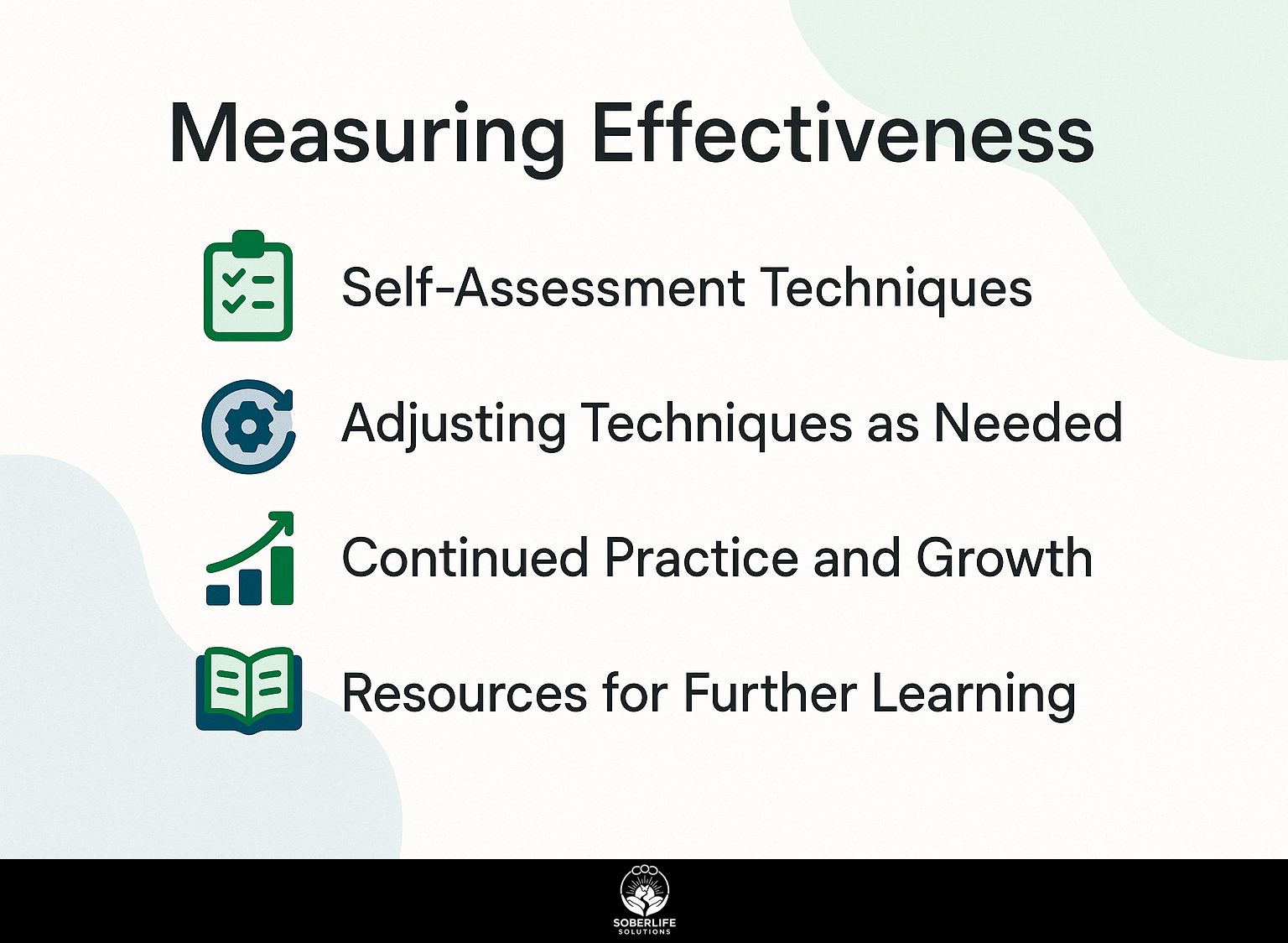
Regularly checking how well deep breathing practices work helps people see their progress and change their techniques to get the best results. One of our hidden gems on developing self-care habits dives deeper into how such practices can be optimized for recovery.
Self-Assessment Techniques
Utilizing self-assessment techniques, such as journaling mood changes, can help individuals evaluate the impact of deep breathing practices on their emotional well-being.
To effectively implement this, individuals can set aside 10 minutes daily for reflection. Document specific moods before and after deep breathing sessions, noting triggers and durations of exercises.
Using the Patient-Reported Outcomes Measurement Information System (PROMIS) helps monitor changes in emotional and physical health. Review your emotions weekly, focusing on anxiety and any improvements in your feelings.
This method helps find patterns and makes it easier to see how deep breathing affects emotional health.
Adjusting Techniques as Needed
Being open to changing your breathing methods based on your own experiences is important for getting the most benefits in managing stress and regulating emotions.
For example, if you find that deep abdominal breathing calms you more than chest breathing, prioritize that method.
Use tools like the Breathwrk app, which leads you through different breathing methods suited to your needs. Try different practices such as:
- 4-7-8 breathing, where you inhale for 4 seconds, hold for 7, and exhale for 8.
Monitor your stress levels before and after each session, adjusting techniques based on effectiveness. Thinking regularly about your experiences can help you find what really strengthens your ability to handle emotions.
Continued Practice and Growth
Regular practice of deep breathing can greatly improve emotional balance and help manage stress that might come up later.
To enjoy these benefits, include deep breathing in your daily schedule. Start by dedicating five minutes each morning to a focused practice, where you inhale deeply through your nose, hold for a count of four, and exhale slowly through your mouth.
Gradually increase this time as you become more comfortable. Use moments of stress-like during a hectic workday-as cues to pause and breathe deeply.
Apps like Calm or Headspace provide guided sessions that can help maintain this habit, ensuring it becomes an integral part of your life.
Resources for Further Learning
Many useful resources, such as books, online courses, and workshops, are available for those who want to learn more about deep breathing and mindfulness practices.
For books, ‘The Mindful Way Through Depression’ by Williams and Teasdale is a great starting point, highlighting mindfulness techniques to combat negative thoughts.
Online, platforms like Headspace and Calm offer interactive courses focused on deep breathing practices. Workshops such as Mindfulness-Based Stress Reduction (MBSR) can provide immersive experiences, reinforcing these skills.
Combining these resources can create a well-rounded approach, enabling individuals to integrate mindfulness into their daily lives effectively.
Frequently Asked Questions
What are deep breathing techniques?
Deep breathing exercises consist of taking slow and deep breaths to help control and calm the body’s reaction to stress and anxiety. These techniques can be beneficial in preventing relapse by promoting relaxation and reducing cravings for addictive substances or behaviors.
How can deep breathing help in relapse prevention?
Deep breathing can help in relapse prevention by providing a healthy and effective coping mechanism for managing stress and anxiety. By using deep breathing techniques, individuals can learn to regulate their emotions and reduce the risk of turning to addictive behaviors as a means of coping.
Are there specific deep breathing techniques for relapse prevention?
There are various deep breathing techniques that can be used for relapse prevention, such as diaphragmatic breathing, alternate nostril breathing, and 4-7-8 breathing. It is important to find the technique that works best for you and practice it regularly to reap the benefits in preventing relapse.
How often should I practice deep breathing for relapse prevention?
It is recommended to practice deep breathing for at least 5-10 minutes daily, but it can be practiced as often as needed throughout the day. Adding deep breathing to your daily habits helps in managing stress and avoiding relapse.
Can deep breathing be used in conjunction with other relapse prevention techniques?
Yes, deep breathing can be used in conjunction with other relapse prevention techniques, such as mindfulness practices and therapy. By using a mix of methods, people can develop a complete plan to prevent relapse that tackles their unique needs and triggers.
Can deep breathing be practiced in any setting?
You can practice deep breathing anywhere, making it an easy and available method to help prevent relapse. It can be done at home, at work, or in public places, providing individuals with a portable tool for managing stress and reducing the risk of relapse.

